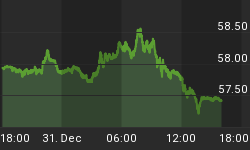Two years ago in The Return of Capital, Not The Return on Capital, we stated: "...as an indicator of a major trend reversal, 'Tens of thousands' of Japanese homemaker-traders are leveraging their bets on a fall in the yen. As global margin calls come in, investors will unwind their positions, and the homemaker-traders will find that they were the last ones to the party. We expect the Yen to appreciate for the long term, causing major pain for these novice investors." The weekly chart below of the Japanese Yen shows just how wrong those homemaker-traders have been.

With that in mind, this week's Wall Street Journal article: Small investors make big bets on currencies should be of interest. It reports that U.S. day traders are trading in foreign currency with leverage "as much as 500 to 1. That allows an investor to put up just a few hundred dollars of capital to make a bet of tens or hundreds of thousands of dollars." How widespread is this kind of trading? It "now approaches $120 billion. That is up about 20% from a year ago and nearly double the level three years ago, according to Aite Group, a Boston-based financial-services industry research and advisory firm." And why are these neophytes drawn to trading foreign currency? "The heightened interest in currency trading comes as the dollar is sagging." Just as in 2007, we have novice day traders betting with large leverage on a falling currency. Expect a similar uptrend in the depressed currency, this time the U.S. dollar, as leveraged day traders meet a fate similar to the Japanese homemaker-traders of two years ago.
The Death of Diversification
The U.S. dollar, just like the Yen in 2007, is being used in "carry trades, which allow traders to borrow cheaply in low-yielding currencies" and "give speculators like big hedge funds and prop trading desks at major Wall Street firms extra leverage to engage in ultra-low-cost speculation and reap rich rewards." Dr. Marc Faber assisted us in describing the Yen carry trade environment back in January of 2007: "the art dealers are bullish on art, the commodity traders bullish on commodities, the real estate guys bullish on real estate, the stock traders bullish on stocks, everybody has something to buy."
Now, the dollar carry trade has created the same problem for wise investors looking for undervalued investments.
"Investors are moving in lockstep like never before, driving up stocks, commodities and emerging markets and risking a replay of last year, when they all plunged the most since World War II. The Standard & Poor's 500 Index, whose increase in the past three months was the steepest in seven decades, is rallying in tandem with benchmark measures for raw materials, developing- country equities and hedge funds. The so-called correlation coefficient that measures how closely markets rise and fall together has reached the highest levels ever, according to data compiled by Bloomberg." - Financial Times
In last year's unwind, diversification did not reduce portfolio risk. When all asset prices are overinflated by credit (through a large supply of/weak currency) there is only one haven; the formerly weak currency. As we recommended two years ago: "Therefore the wise contrarian strategy is interest-bearing cash. Over the next few years, most assets will fall in value as risk returns to the market and leverage is unwound." With sentiment levels extremely one sided (only 3% of traders surveyed were bullish on the dollar), a swing in the emotional pendulum will reverse the dollar carry trade and cause speculative investments (which would include most assets) to collapse.
***More For Clients and Subscribers***
With sentiment higher than it was at the peak in October 2007 and the market rising since March on waning volume, an Acapulco cliff dive from current levels would not be surprising. Time magazine described the scene during the Crash of 1929: "Around the floor word spread that the House of Morgan and the New York banks had put a cushion under the market. The market rallied. It looked as if the Morgan "miracle" had staved off disaster." What followed was Black Tuesday:
"From the bell's first ring, it was panic; by day's end an incredible 16,410,030 shares had been dumped, capping the selling that had wiped out an estimated $25 billion in stock values. Not until 2½ hours after the market's close did the tickers catch up and carry the final sale. There was no longer any attempt by bankers or anybody else to stem the collapse. In just six days the whole world of easy prosperity had been buried."
Predicting A Major Decline
Crashes are very rare and are almost impossible to predict. Yet the likelihood of their occurrence can be very high if conditions are ripe. As always, we warn that anything can happen. All we can do is assess the current environment, learn from historical examples and attempt to stay ahead of the herd. We continue to recommend that investors protect principal.
As Paul Tudor Jones stated when predicting the Crash of 1987, we wait for "...some type of decline, without a question...it will be earthshaking, it will be saber rattling, and it will have Wall Street in a tizzy and it will create headlines, that will be, that will dwarf anything that has happened to this point in time."
At Lamont Trading Advisors, we provide wealth preservation strategies for our clients. For more information, contact us . Our monthly Investment Analysis Report requires a subscription fee of $40 a month. Current subscribers are allowed to freely distribute this report with proper attribution.
***No graph, chart, formula or other device offered can in and of itself be used to make trading decisions. This newsletter should not be construed as personal investment advice. It is for informational purposes only.
















